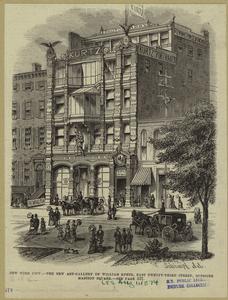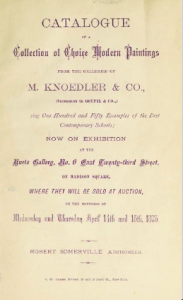Active Dates: 18741Benson Lossing, History of New York City: Embracing an Outline Sketch of Events from 1609 to 1830, and a Full Account of Its Development from 1830 to 1884, Volume 1 (New York: Perine Engraving and Publishing Company, 1884), 414. -18832Emil Carlsen Archives, “American Art Association” (webpage), Emil Carlsen Archives, accessed April 14th, 2020, http://emilcarlsen.org/portfolio/american-art-association-1883-1964/
Gallerist: William Kurtz (1833-1904)3 “William Kurtz, 1833-1904,” Newspaper Clipping, The Miriam and Ira D. Wallach Division of Art, Prints and Photographs: Print Collection, The New York Public Library, Accessed April 14, 2020, http://digitalcollections.nypl.org/items/510d47e2-a868-a3d9-e040-e00a18064a99
Location:
1874-1883: 6&7 East 23rd Street, New York4Lossing, History of New York City, 414.
Specialty: European and American pictures.5“Pictures at the Kurtz Gallery,” New York Times, December 17th, 1876, p 7. Kurtz ran a photography studio on the ground floor of the Kurtz Gallery, specializing in photographic portraits.6“William Kurtz, 1833-1904,” The New York Public Library.
Gallery History
The Kurtz Gallery opened in 1874 facing Madison Square Gardens on East 23rd street as a photography studio and picture gallery. William Kurtz emerged as a prominent figure in the American photography scene after a varied early career as a lithographer in Germany, soldier, and sailor. Rescued from a shipwreck and brought to New York, Kurtz worked in several photo galleries and fought in the civil war before opening the Kurtz gallery in 1874. The lively gallery employed 40 assistants and occupied a decorative multistory building worth $130,000 in 1883.7Lossing, History of New York City, 414.
Visitors enjoyed galleries on upper levels and open gathering spaces for special events such as poetry readings and speakers.8“New York City–the reception to William Cullen Bryant given by the Goethe Club, November 14th–Mr. Bryant responding to the address of welcome,” Still Image, The Miriam and Ira D. Wallach Division of Art, Prints and Photographs: Picture Collection, The New York Public Library, 1877-12-01, Accessed April 14th, 2020, http://digitalcollections.nypl.org/items/510d47e1-10db-a3d9-e040-e00a18064a99. The gallery featured artists from both Europe and America including Hunt, Gifford, Johnson, Zamacois, Fromentin, Vibert, Simonetti, Coret, Breton, and Degraffe among many others.9“Pictures at the Kurtz Gallery.” Highlights included high caliber shows such as exhibitions organized by famous art dealer Knoedler, featuring “One Hundred and Fifty Examples of the Best Contemporary Schools” in 1875.10“Catalogue of a collection of choice modern paintings from the galleries of M. Knoedler & Co…” Getty Research Institute Internet Archive, Accessed April 14th, 2020, https://archive.org/details/catalogueofcolle00some/page/n14/mode/2up A few years later, a notable show on young, emerging artists gained significant attention.11“A Plea for Finish in Art.” New York Times. March 17th, 1878. The ambiance of the gallery was considered one of the “finest in the city” for its decorations, flowers, and elegant New Yorkers.12Richard Edwards, New York’s Great Industries: Exchange and Commercial Review, (New York: Historical Publishing Company, 1884), 275. The Kurtz gallery was frequently featured in the New York Times and other news publications.13 “A Plea for Finish in Art”
Alongside shows, Kurtz ran a photography studio on the ground level of the gallery. As an accomplished experimenter and innovator in the field of photography, Kurtz had made a name for himself in inventing the “Rembrandt Effect” in portrait photography as well as the vibrotype and the conigraph devices.14Lossing, History of New York City, 414. He also pioneered picture retouching to capture more sensitivity in facial expressions.15David Shields, “William Kurtz,” Broadway Photographs, accessed April 14th, 2020, https://www.broadway.cas.sc.edu/content/william-kurtz In 1883, Kurtz installed electric light which illuminated his studio and attracted a lucrative business in photographing high-society New Yorkers in their finery after attending balls, operas, and parties.16Edwards, New York’s Great Industries, 275. Kurtz became an expert in reproduction and was awarded recognition in Paris, Vienna, and Philadelphia expositions. William Kurtz was the first American photographer to win these honors,17 Lossing, History of New York City, 414. and over time he grew one of the largest photographic repositories in the world, specializing in busts and portraiture.18“William Kurtz, 1833-1904,” The New York Public Library. Later, Kurtz championed colored photographic reproduction.19Shields, “William Kurtz.”
In 1880, James Sutton took over the Kurtz Gallery and renamed the space the American Art Gallery.20 Malcom Goldstein, Landscape with Figures: A History of Art Dealing in the United States, (Oxford: Oxford University Press, 2000), np. Soon after, the American Art Association was established in the Kurtz building the 1883. The association became the first American auction house and remained on East 23rd street until the American Art Association moved to Madison Ave and 56th Street in 1922.21“Selected Dealer Archives & Locations,” The Getty Research Institute, Accessed April 14th, 2020, https://www.getty.edu/research/tools/guides_bibliographies/provenance/dealer_archives.html.
Date Written: April 15th, 2020
Author’s Initials: CT
Illustrations


The Getty Research Institute.

Primary Sources
“A Plea for Finish in Art.” New York Times. March 17th, 1878. https://timesmachine.nytimes.com/timesmachine/1878/03/17/81722778.pdf?pdf_redirect=true&ip=0
Edwards, Richard. New York’s Great Industries: Exchange and Commercial Review. New York: Historical Publishing Company, 1884. https://books.google.com/books?id=d6ieSXFM2kIC&printsec=frontcover&source=gbs_ge_summary_r&cad=0#v=onepage&q=kurtz&f=false
“Pictures at the Kurtz Gallery.” New York Times. December 17th, 1876, p 7. https://timesmachine.nytimes.com/timesmachine/1876/12/17/81700930.html?auth=login-email&pageNumber=7
“Catalogue of a collection of choice modern paintings from the galleries of M. Knoedler & Co.: (successors to Goupil & Co.): comprising one hundred and fifty examples of the best contemporary schools: now on exhibition at the Kurtz Gallery, no. 6 East Twenty-third Street, on Madison Square, where they will be sold at auction on the evening of Wednesday and Thursday April 14th and 15th, 1875.” Getty Research Institute Internet Archive. Accessed April 14th, 2020. https://archive.org/details/catalogueofcolle00some/page/n14/mode/2up
“New York City–the new art gallery of William Kurtz, East Twenty-third Street, opposite Madison Square.” The Miriam and Ira D. Wallach Division of Art, Prints and Photographs: Picture Collection, The New York Public Library. Accessed April 14th, 2020. http://digitalcollections.nypl.org/items/510d47e1-2cf8-a3d9-e040-e00a18064a99
“New York City–the reception to William Cullen Bryant given by the Goethe Club, November 14th–Mr. Bryant responding to the address of welcome” Still Image. The Miriam and Ira D. Wallach Division of Art, Prints and Photographs: Picture Collection, The New York Public Library. Accessed April 14th, 2020. http://digitalcollections.nypl.org/items/510d47e1-10db-a3d9-e040-e00a18064a99
“William Kurtz, 1833-1904.” Newspaper clipping. The Miriam and Ira D. Wallach Division of Art, Prints and Photographs: Print Collection, The New York Public Library. Accessed April 14, 2020. http://digitalcollections.nypl.org/items/510d47e2-a868-a3d9-e040-e00a18064a99
Secondary Sources
Emil Carlsen Archives. “American Art Association.” Emil Carlsen Archives. Accessed April 14th, 2020. http://emilcarlsen.org/portfolio/american-art-association-1883-1964/
Goldstein, Malcom. Landscape with Figures: A History of Art Dealing in the United States. Oxford: Oxford University Press, 2000. https://books.google.com/books?id=Z9MJCAAAQBAJ&pg=PT99&lpg=PT99&dq=rufus+moore+kurtz+gallery&source=bl&ots=IL0VqbbGkR&sig=ACfU3U308uNkEQOyvlj7wWIqt98IJK-2dQ&hl=en&sa=X&ved=2ahUKEwivrNOGjufoAhUIgK0KHTXAALsQ6AEwAHoECAsQKQ#v=onepage&q=rufus%20moore%20kurtz%20gallery&f=false
Lossing, Benson, History of New York City: Embracing an Outline Sketch of Events from 1609 to 1830, and a Full Account of Its Development from 1830 to 1884, Volume 1. New York: Perine Engraving and Publishing Company, 1884. https://books.google.com/books?id=MZZe-BT4BbwC&pg=PA414&lpg=PA414&dq=kurtz+gallery+nyc+catalog&source=bl&ots=5gpJcDXgte&sig=ACfU3U3eDoz-xLD7PgxTUWtXdjI9ectENw&hl=en&sa=X&ved=2ahUKEwiGzvTvhOToAhVDX60KHegjChYQ6AEwB3oECAwQLw#v=onepage&q=kurtz%20gallery%20nyc%20catalog&f=false
Shields, David S. “William Kurtz.” Broadway Photographs. accessed April 14th, 2020. https://www.broadway.cas.sc.edu/content/william-kurtz
“Selected Dealer Archives & Locations.” The Getty Research Institute. Accessed April 14th, 2020. https://www.getty.edu/research/tools/guides_bibliographies/provenance/dealer_archives.html